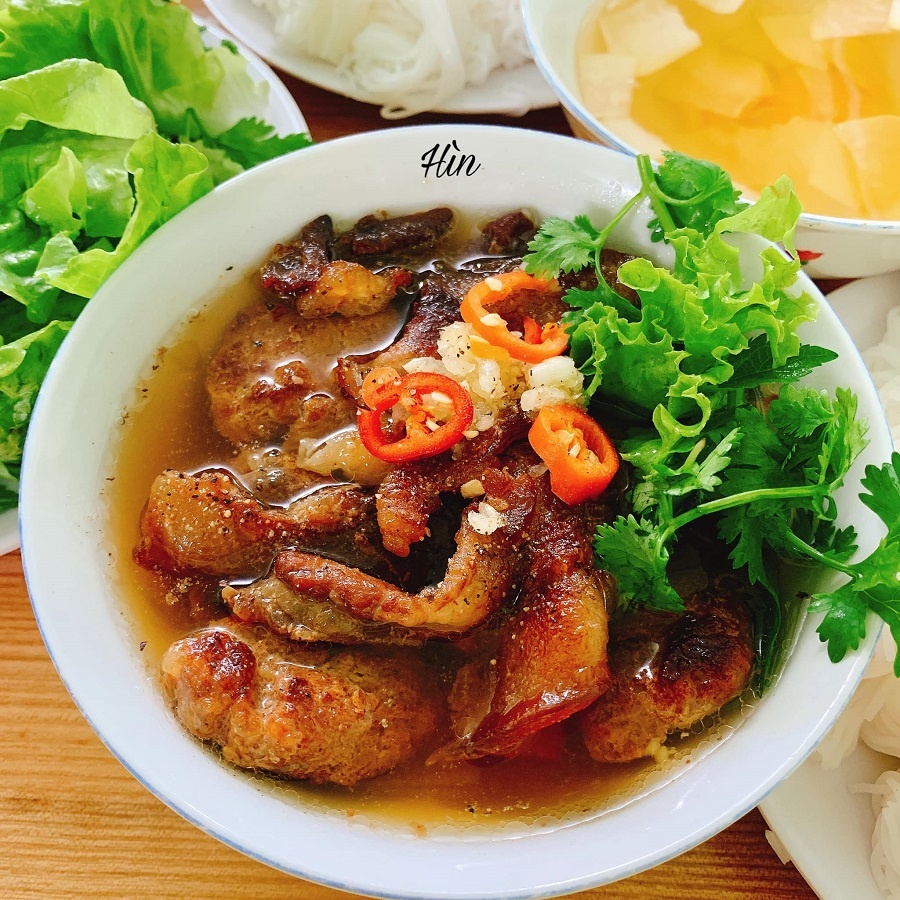According to CNN, noodles act as an “unsung hero”, creating the texture and substance for many dishes in Asia countries.
| A should-not-to-miss specialty of Hanoi for any traveler: Bun cha or grilled pork with fresh rice noodle. Photo: Phuong Linh |
The site quoted Tang Pui Sum, director of Hong Kong’s 60-year-old Yau Kee Noodles Factory: “Noodles may only be a sidekick – taking up about 10% of the cost of a dish – but without the right noodles, a meal will be ruined”.
Asian noodle varieties combined with different ingredients and recipes result in unique dishes, among which three representatives from Vietnam must be mentioned.
Pho – Vietnamese traditional flat rice noodles soup with beef
Topping the CNN list is flat rice noodles. This is a popular ingredient used in countless signature dishes across Asia, from pad thai (Thai-style stir-fried noodles) to Cantonese pan-fried beef ho fun, Malaysian char kway teow and Vietnamese pho.
To make flat rice noodles, rice flour and water are kneaded into a mixture that’s rolled into a thin rice sheet, then steamed and cut into different sizes.
Cantonese ho fun is often brushed with a thin layer of oil after steaming to give it a smooth texture. Meanwhile, “in Thailand and Vietnam, they sometimes dry the noodles right after steaming so that they don’t need the extra layer of oil,” Tang said.
Previously, in 2019, CNN readers voted pho one of the 50 best dishes in the world. In addition, another US news site – Business Insider – once hailed pho as the best Vietnamese dish, while their readers voted enjoying the dish in Hanoi among 100 must-try travel experiences in a lifetime.
Similarly, Canadian’s the Travel Magazine honored pho as a quintessential dish in Vietnamese cuisine. As recommended by the magazine, besides Hanoi’s pho, there are also famous pho restaurants in Ho Chi Minh City that tourists should try when coming here, including Pho Hoa, Pho Le, Pho Tau Bay, and Ky Dong Chicken Pho and Glass Noodles.
| The best specialty of Hanoi: Pho bo or Rice noodle soup with beef. Photo: Le Phong |
Bun or rice stick noodles
Next, rice sticks are a preferred ingredient thanks to its smooth texture and faint scent. Among the dishes with rice sticks as the base in Vietnam, CNN is most impressed by bun cha Hanoi, describing that rice stick noodles are eaten cold with grilled pork, herbs and dipping sauce.
Bun cha Hanoi was also voted by CNN readers as the best dish of summer in 2012. In 2014, bun cha once again made it to the list of 10 best street foods in National Geographic magazine.
In particular, in 2016, many foreign newspapers such as Telegraph, Daily Mail or CNN reported on US President Obama and late celebrity chef Anthony Bourdain coming to eat at Bun Cha Huong Lien restaurant at 24 Le Van Huu, Hai Ba Trung District in Hanoi, once again enhancing the dish’s international reputation.
| The dish of Bun cha at Bun cha Lien Huong Restaurant in Hanoi. Photo: Phuong Linh |
Cao Lau rice noodles
Finally, CNN gives plenty of praise to Vietnamese’s Cao lau.
A ubiquitous dish in Hoi An Ancient Town, Cao lau consists of barbecue pork slices, crispy fried croutons and a special type of rice noodles.
“Cao lau may look simple but takes a lot of time as well as sophisticated processing,” said Trinh Diem Vy, a celebrity chef and owner of nine restaurants in Hoi An told CNN.
These firm noodles are made of old long grain rice with the water taken from Ba Le Well, an ancient well in Hoi An.
“The minerals from the water provide the right elements for the noodle texture,” Vy explained. To give the noodles a yellowish hue and unique springy texture, the flour is kneaded and thinly sliced, then steamed several times.
US news site HuffPost (formerly The Huffington Post) also featured an article praising Cao lau as one of the most unique dishes in the rich culinary treasure of Vietnam.
| The Cao lau Hoi An- another Vietnamese specialty. Photo: Thanh Van |
Sharing the same sentiment with CNN, HuffPost believes that the noodles are the highlight and also the main ingredient to create the distinctiveness of Cao lau. There seems to be only a few who really know the recipe, so the story about how to make the food is a legend.
First, the water for the noodles must be taken from the ancient Ba Le Well – which is not known by many people, then mixed with the firewood ash taken from Cu Lao Cham – the islands off the coast of Hoi An, before grain rice is soaked in.
The process of making Cao Lau consists of more separate steps. Although only a few families in Hoi An know the secret recipe, more and more people are devising their own.
As the HuffPost article affirmed, whether today’s Cao lau dish is made with ancient well water and Cu Lao Cham ash or not, is not too important. What matters is that it still retains the traditional flavor, imbued with the cultural identity of an ancient town.
The combination of ingredients, accompanied by the intriguing story behind the processing stages, create a special charm for this unique dish of Hoi An.








